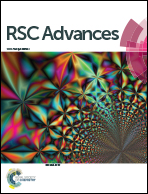Cyclic voltammetric deposition of discrete nickel phosphide clusters with mesoporous nanoparticles on fluorine-doped tin oxide glass as a counter electrode for dye-sensitized solar cells
Abstract
A monolayer of widely spaced nickel phosphide clusters with mesoporous nanoparticles was directly formed on fluorine-doped tin oxide glass by cyclic voltammetric deposition as a counter electrode for a dye-sensitized solar cell (DSC). Cyclic voltammetry included the anodic dissolution of Ni-rich regions following the cathodic deposition, leading to the formation of discrete clusters with mesoporous nanoparticles. After annealing at 500 °C, the nickel phosphide could be characterized as Ni5P4 and its electrocatalytic behavior was evaluated by cyclic voltammetry and electrochemical impedance in an iodide/triiodide system. The mesoporous Ni5P4 catalyst prepared by the cyclic voltammetric method exhibits good electrocatalytic ability towards the iodide/triiodide redox couple as a result of its low charge-transfer resistance and diffusion impedance. The photoelectron conversion efficiency of a DSC employing the Ni5P4 counter electrode could reach 7.6%, which is higher than that of a DSC employing a Pt nanocluster counter electrode (7.2%). The successful utilization of ultra-low loading of the Ni5P4 catalyst for DSCs makes the application of such material more economically viable.


 Please wait while we load your content...
Please wait while we load your content...